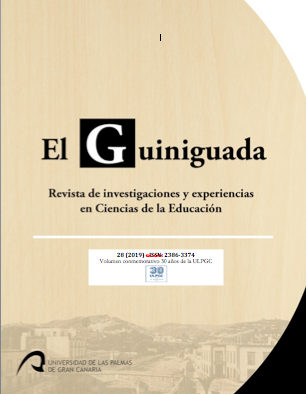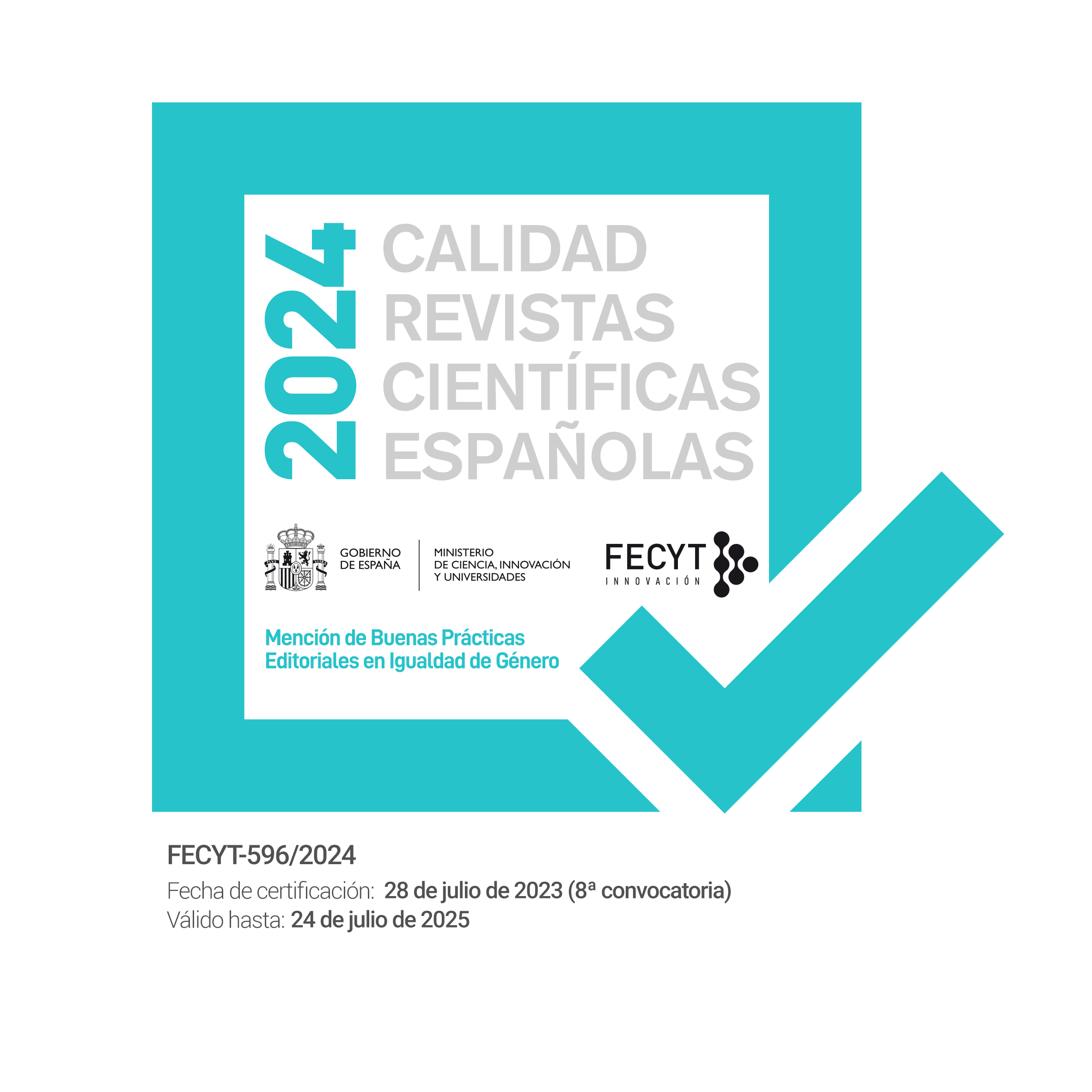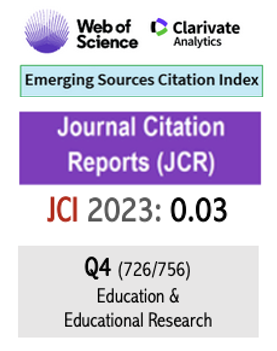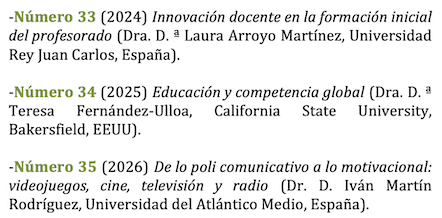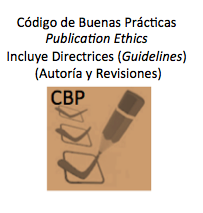This is Hollywood: ready, steady and action! An educational project to improve the English pronunciation at Secondary Education. ¡Esto es Hollywood: preparados, listos y acción! Un proyecto educativo para ... doi 10.20420/ElGuiniguada.2019.266
Palabras clave:
Educational Project, English Pronunciation, Secondary Education, Short films, Oral ExpressionResumen
English has become the lingua franca, and thus, an important tool of communication which has connected the world in a way we never thought. As important as it is, a well understanding in oral situations is needed, as without it, misunderstanding and awkward situations can take place. Pronunciation plays an important role here, since it enables an effective communication with the native speaker. In Spain, the EFL teaching methods still focus more on written skills rather than on oral skills, and thus, the teaching of pronunciation is often push in the background. Cinema provides a genuine and natural environment to work the communicative approach in a motivating way. The purpose of this paper is to present an innovative educational project proposal based on the author’s previous work (Imbernón, 2016) which serves as a model to improve the English level of pronunciation in secondary school students by means of filmmaking activities.
Descargas
Citas
Ausubel, D. (1963). The Psychology of Meaninful Verbal Learning. New York: Grune & Stratton.
Barrera, I. (2009). La importancia de enseñar fonética en el aula de inglés. Innovación y Experiencias Educativas, (23), 1–8.
Bartolí, M. (2005). La pronunciación en la clase de lenguas extranjeras. Phonica, 1.
Bruner, J. S. (1978). The role of dialogue in language acquisition. In A. Sinclair, R. J. Jarvelle, & W. J. M. Levelt (Eds.), The Child’s Conception of Language (pp. 241–256). New York: Springer-Verlag.
Canning-Wilson, C. (2000). Practical Aspects of Using Video in the Foreign Language Classroom. The Internet TESL Journal, 11(4). Retrieved from http://iteslj.org/Articles/Canning-Video.html
Carracedo, C. (2009). Diez ideas para aplicar el cine en el aula. In N. Arriaga, R. Blasco, A. Codinach, A. M. Ducasse, S. González y Fernández-Corugedo, L. López-Fernández, … A. J. Sánchez (Eds.), El currículo de E/LE en Asia-Pacífico. Selección de artículos del I Congreso de español como lengua extranjera en Asia-Pacífico CE/LEAP (pp. 229–267). Manila, Filipinas:Instituto Cervantes de Manila y Embajada de España en Filipinas. Retrieved from https://cvc.cervantes.es/Ensenanza/Biblioteca_Ele/publicaciones_centros/pdf/manila_2009/16_aplicaciones_03.pdf
Cenoz Iragui, M. J. (1993). Diferencias individuales en la adquisición del inglés. Revista Española de Lingüística Aplicada, 9, 27–35. Retrieved from https://dialnet.unirioja.es/servlet/articulo?codigo=1308209
Chan, D., & Herrero, C. (2010). Using film to teach languages: a teachers’ toolkit for educators wanting to teach languages using film in the classroom, with a particular focus on Arabic, Mandarin, Italian and Urdu. Manchester, England: Cornerhouse. Retrieved from https://homemcr.org/media/toolkit-for-teachers-using-film-to-teach-languages/
Consejo de Europa. (2002). Marco Común Europeo De Referencia Para Las Lenguas. Centro Virtual Cervantes. Madrid: Anaya. https://doi.org/10.1007/s13398-014-0173-7.2
Csajbok-Twerefou, I. (2010). The Role of Films in the Teaching of Foreign Languages. Legon Journal of the Humanities, 21, 51–75. Retrieved from https://www.ajol.info/index.php/ljh/article/view/121562/111030
Dörnyei, Z. (1994). Motivation and motivating in the foreign language classroom. The Modern Language Journal, 78(3), 273–284.
Elliott, A. R. (1997). On the teaching and acquisition of pronunciation within a communicative approach. Hispania, 80(1), 95–108.
Imbernón, V. M. (2016). El cine en el aula de Secundaria: un recurso para la mejora de la adquisición de la pronunciación inglesa. Universidad Católica de Murcia, Murcia. Retrieved from http://repositorio.ucam.edu/bitstream/handle/10952/2015/TFM_VIP.pdf?sequence=1&isAllowed=y
Krashen, S. (1982). Principles and Practice in Second Language Acquisition. Oxford: Pergamon.
Munro, M. J., & Derwing, T. M. (2006). The functional load principle in ESL pronunciation instruction: An exploratory study. System, 34(4), 520–531. https://doi.org/10.1016/j.system.2006.09.004
Needlands, J. (2002). Making Sense of Drama. A Guide to Classroom Practice. United Kingdom: Heinemann Educational Publishers.
Norris, J. M. (2009). Task-Based Teaching and Testing. In M. H. Long & C. J. Doughty (Eds.), The Handbook of Language Teaching (pp. 578–594). Oxford, UK: Wiley-Blackwell. https://doi.org/10.1002/9781444315783.ch30
Poorman, P. B. (2002). Biography and Role Playing: Fostering Empathy in Abnormal Psychology. Teaching of Psychology, 29(1), 32–36. https://doi.org/10.1207/S15328023TOP2901_08
Ryan, S. (1998). Using films to develop learner motivation. The Internet TESL Journal, 11(4). Retrieved from http://iteslj.org/Articles/Ryan-Films.html
Sanz González, F. (1999). Las rimas tradicionales inglesas y la enseñanza del ritmo del inglés oral en Primaria. Didáctica (Lengua y Literatura), (11), 123–144.
Selinker, L. (1972). Interlanguage. International Review of Applied Linguistics in Language Teaching, 10(3), 209–232.
Suh-ching Li, L. (2008). El uso del cine en el aula de E/LE: un ejemplo de la clase de conversación en Taiwán. In SM.Saz (Ed.), Acortando distancias: La diseminación del español en el mundo. Actas del XLIII Congreso Internacional de la Asociación Europea de Profesores de Español (pp. 297–305). Madrid: Edelsa. Retrieved from https://cvc.cervantes.es/ensenanza/biblioteca_ele/aepe/pdf/congreso_43/congreso_43_40.pdf
Tatsuki, D. H. (2000). Developing Film Study Guides. The Internet TESL Journal, 3(4). Retrieved from http://iteslj.org/Techniques/Tatsuki-StudyGuides.html
Tömösváryová, M. (2009). Teaching Multicultural Education via Techniques of Drama Education. Masaryk University, Czech Republic. Retrieved from https://is.muni.cz/th/183802/pedf_b/?lang=en;id=281911
Publicado
Cómo citar
Número
Sección
Licencia
El Guiniguada se distribuye en abierto bajo una licencia Creative Commons Reconocimiento–NoComercial–SinObraDerivada 4.0 Internacional. Permite pues que los autores/as retengan, sin restricciones, los derechos de autoría así como los de publicación y difusión (esta última en una web personal o en un repositorio institucional). Igualmente, los artículos pueden ser descargables y compartirse siempre que se reconozca la autoría, que no se realicen cambios y que no se utilicen comercialmente (CC BY-NC-ND). En los números anteriores a 2020 los derechos de autor/a eran transferidos a la Revista, pero desde el Volumen 29 (2020) se aplica la política de derechos de autoría actual.
La Revista proporciona por tanto un acceso abierto inmediato a su contenido basado en el principio de que ofrecer al público un acceso libre a las investigaciones ayuda a un mayor intercambio global de conocimiento, de acuerdo con la definición BOAI de acceso abierto. Los autores/as no pagan por publicar en El Guiniguada.
El destinatario principal de esta publicación es la comunidad científica en general. No obstante, dado el interés social de los temas vinculados con la educación, El Guiniguada es consciente de la previsible proyección general que sus volúmenes puedan tener. Su acceso abierto permite, igualmente, el conocimiento libre y general de su contenido.
Quienes publiquen en esta revista aceptan pues los términos siguientes:
- Conservarán sus derechos de autoría y garantizarán a la revista el derecho de primera publicación de su obra, el cual estará simultáneamente sujeto a la Licencia de reconocimiento de Creative Commons que permite a terceros compartir la obra siempre que se indique su autoría y su primera publicación en esta revista. Asimismo, se indica que no se puede hacer un uso comercial de la obra; tampoco está permitido su uso derivado.
- Podrán adoptar otros acuerdos de licencia no exclusiva de distribución de la versión de la obra publicada (p. ej.: depositarla en un repositorio institucional o publicarla en un volumen monográfico) siempre que se indique la publicación inicial en esta revista.
- Podrán difundir su obra a través de Internet (p. ej.: en archivos telemáticos institucionales o en los perfiles académicos o profesionales de los autores...) antes y durante el proceso de envío, lo cual puede producir intercambios interesantes y aumentar las citas de la obra publicada. (Véase El efecto del acceso abierto).
Asimismo y de acuerdo con la política de acceso abierto BOAI, todo el contenido está disponible gratuitamente sin cargo para el usuario o su institución. Los usuarios pueden leer, descargar, copiar, distribuir, imprimir, buscar o vincular los textos completos de los artículos, o usarlos para cualquier otro propósito legal, sin solicitar permiso previo del equipo editorial o de la autoría.
